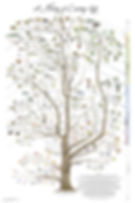Living Fossils
- Maarten
- Nov 29, 2021
- 3 min read
In the garden of the natural history museum in Paris they stand side by side: A ginkgo and a mammoth. Two species that were only known as fossils in the West for a long time. The ginkgo is more than 270 million years old and was "rediscovered" in southwest China. The mammoth disappeared from the scene about 4,000 years ago, after splitting off from the Asian elephant about 5 million years ago. The ginkgo thus witnessed the rise and fall of the mammoth. A special achievement for a tree species that can only move slowly with the changing climate zones. We previously wrote about the special (and long) history of the ginkgo and the sequoia. But what actually makes these trees living fossils? In this blog you can read all about it.

Tree of life
The history of life on Earth is incredibly diverse, going back about 3.8 billion years. Palaeontologists estimate that 99.9% of all species that have ever lived are now extinct [1]. In many illustrations - each more beautiful than the other - an attempt is made to summarise the rich history of life in one image. Our favourite: the Fairhopegraphics 'tree of life', with an overview of (a number of) living species. This clearly shows that the gymnosperms (gymnospermae - to which the ginkgo, conifers and cycads belong) are much older than the angiosperms (angiospermae - to which all flowering plants belong). The first flowering plants appeared 'only' 125 million years ago, after which the species richness expanded at a geological speed. With an estimated number of 300,000 species, the angiosperms represent about 80% of all living plants [2].

Photo credit: https://fairhopegraphics.com/
What is a living fossil?
'Living fossil' generally refers to a plant or animal that is very similar in appearance to an ancestor known from fossils. In reality, a lot has changed genetically in the intervening millions of years. However, due to the evolutionary process of 'stabilizing selection', no new species have arisen from the original ginkgo. In fact, the ginkgo has only gotten better at what it does. The genome of the ginkgo is 3 times as long as that of humans and contains many defense mechanisms against fungi, bacteria and chemicals. It has become a very strong survivor with the same 'looks' as 270 million years ago.

CC BY-NC-SA 2.0, Tony Rodd on Flickr
The edge of the abyss
Even more ancient beauties can be found in the plant kingdom. Notable examples are the cycads (Cycadales), the Japanese umbrella pine (Sciadopitys verticillata), which no longer has any living close relatives, and the monkey tree family (Araucariaceae). Of this last family, the story of the Wollemia nobilis appeals most to the imagination. The tree had been known as a fossil for decades (found in Antarctica, among others!) and was labeled extinct. Until 1994, in a remote valley of the Australian blue mountains, a group of living specimens was found. It concerns less than 100 trees, many of which are connected by roots. Research has shown that these trees are genetically identical. It is likely that the population was once reduced to just 1 or 2 individuals [3]. A strong example of balancing on the edge of the abyss. Fortunately, the species is easy to propagate and sow. They can now be admired all over the world in botanic gardens and they come on the market here and there.
Which living fossil would you like to see in our range? Let us know! If we include it in the range, you will be the first to receive this species.
Sources
[1] https://www.encyclopedia.com/daily/is-it-true-that-99-9-of-all-species-are-extinct/
[2] https://www.britannica.com/plant/angiosperm
[3] https://doi.org/10.1046%2Fj.1365-294X.2003.01926.x